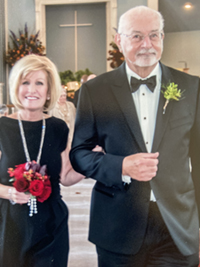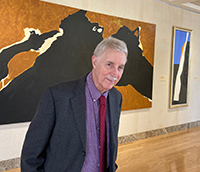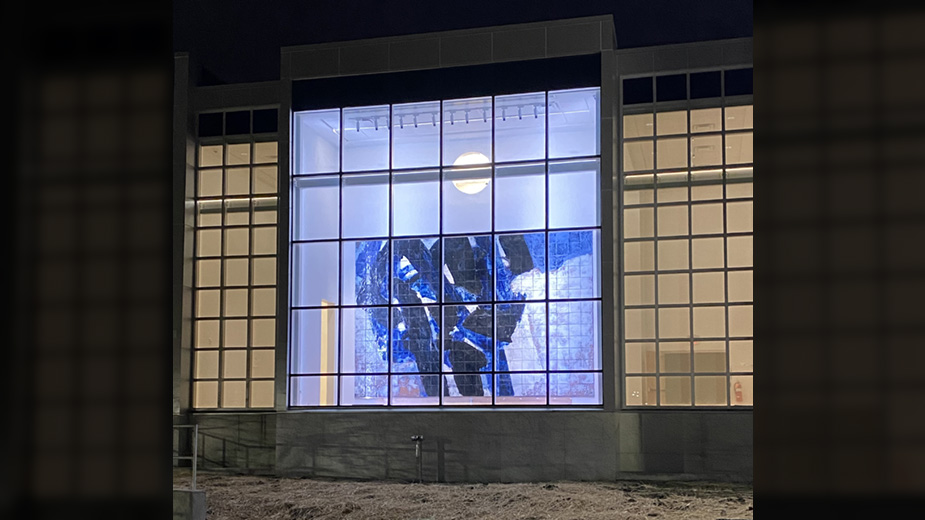YOUNGSTOWN, Ohio – If ever there was a work of art that deserves – and perhaps requires – its own wing, it is “14 May, 1968.”
Through a lot of persistence and effort, that is exactly what has happened.
The Butler Institute of American Art acquired the massive ceramic mural by the late French artist Pierre Soulages in 2009. On April 14, it unveiled the Bacon Wing, which includes a display window custom-built for the mural, as well as two galleries and some storage space.
The 14-foot-by-20-foot mural, which weighs over 1,000 pounds, is now displayed behind a window wall in the wing that is lit at night so passing motorists can see it.

It has become the latest signature of a museum that is already known for its art and its architecture.
The new wing is practically a necessity to fully appreciate the giant mural, and the $2 million addition – which took a year to build – gives it a permanent home befitting a masterpiece.
Along with the unveiling of the Soulages mural April 14, two giants of The Butler museum were honored: Louis A. Zona, the longtime executive director and curator of The Butler; and C. Robert Buchanan, the architect who designed the Bacon wing and just about every other addition to the museum.
The story of how Soulages’ mural finally arrived at its forever home in Youngstown is both colorful and circuitous, with many bumps along the way.
“I’d like to say that we were confident all along [that the mural would come to rest at The Butler],” Zona said. “We did all the work. We discovered it and saved it, installed it and protected it. It’s a love affair.”
Of all the great works of art acquired under Zona’s tenure, none is more closely associated with him than the Soulages mural. Zona’s connection to the mural is almost as strong as his connection to the museum itself.
History
Soulages – who died in October at age 102 and is considered one of France’s greatest artists – created the mural in 1969 under commission by the owners of the Oliver building, a skyscraper in Pittsburgh. It was the centerpiece of the building’s lobby for decades.
The piece consists of 294 ceramic tiles held together and mounted with metal brackets.
In the late ’60s and early ’70s, The Butler’s Zona was a graduate student at Carnegie Mellon University in Pittsburgh. He would often visit the Oliver building just to marvel at the mural.
Zona became director of The Butler in 1981 but never lost his admiration for the mural. In 2004, he contacted the owners of the Oliver building with an offer to purchase it. That offer was rejected, but changes were coming.

In 2009, an attorney for the building’s owners contacted Zona to see if he was still interested in the mural. But Zona had to decline because Max Draime, The Butler board member who intended to purchase the piece, had died three years prior.
The attorney then made a surprising counteroffer. He said the Butler could have the mural – which is practically priceless today – if it could remove it from the wall and transport it away within two weeks.
He knew that removing the piece would be a complex task. And there was one other requirement: The crew could work only at night when the building was closed.
“They didn’t want the lobby to look like a construction zone,” Zona recalled. The owners had previously made the same offer to Carnegie Mellon University, which declined because of the difficulty of the task.
The first conservator Zona sent to analyze the project delivered a deflating prognosis. “He called and said he couldn’t do it,” Zona recalled. The call came during a Butler board meeting. Noticing the disappointment on Zona’s face, board member Vincent Bacon asked what was wrong.
“He said, ‘Tell me about the problem,’ and I did,” Zona recalled. “Then he said he would go take a look at it.”
Bacon, an engineer, would soon call with happy news. “He said, ‘Hey, Lou, I think I can get it off the wall,” Zona said. “Each piece was mounted onto a concrete wall with metal rods, but he did it without any breakage.”
The mural was transported from Pittsburgh to Bacon’s garage in the Mahoning Valley. Zona was able to raise the money to build an addition to The Butler’s Trumbull Branch in Howland, which then became the home of the mural. Like the new addition in Youngstown, the Howland project also had a glass window wall that allowed passing motorists to see the mural.
Foundation Medici, owner of the Howland branch building, ended its relationship with The Butler in 2019 and filed a lawsuit to retain ownership of the mural.
After a long court battle, the Ohio Supreme Court in December upheld lower court rulings and awarded ownership of the mural to The Butler, which had already begun work on the building addition.
A letter written by the late Soulages and sent to Zona many years ago has been transferred into calligraphy and mounted in the new wing, near the mural. In the letter, Soulages thanks Zona and others for rescuing his mural from potential destruction.
Two much smaller Soulages paintings are also on exhibit in the wing.
A Salute
The event April 14 that unveiled the addition and the mural also saluted the men who made the Soulages wing happen and, indeed, who elevated the museum to the world-class status it enjoys today. They are:
• Zona, who has been at the helm for the growth of the building and its art collection;
• Bacon, the longtime benefactor who also lent his engineering expertise countless times, and for whom the new addition is named;
• Buchanan, the architect who designed the wing and just about every other addition to The Butler.
Zona, who has been executive director for over 40 years, was humble and typically low-key when asked about the honor and his accomplishments.
“I love what I do,” he said. “What’s the old saying? If you love what you do, you will never work a day in your life. I have devoted my life to The Butler.”
The new addition to The Butler is known as the Vincent and Phyllis Bacon Wing. But it’s just the latest element of the museum named for the Bacons. The list also includes Bacon Hall, Bacon Great Hall and the Bacon Gallery.
Bacon said he is proud to be associated with The Butler.
“Bob Buchanan called the museum ‘a little jewel box,’ and it fits very well,” Bacon said.
The physical growth of the building over the decades is “amazing,” he continued.
Expansions to the original 1919 building include the Beecher Court (1987), the Sculpture Court (1990), the Beecher Center Addition (2000), the Andrews Pavilion (2003) and the Butler North building, an existing former church that was acquired in 2013 and connected to the museum by the Bitonte Skywalk.
“Mr. Butler would be impressed to see how much it has expanded,” Bacon said. “He would be impressed with The Butler’s board and its collection.”
The Butler was founded in 1919 by Youngstown industrialist and philanthropist Joseph G. Butler.
In designing the addition, architect Buchanan kept several things in mind.
“The purpose was to create space for the large Soulages mural and to also have high ceilings for [the gallery behind it],” he said. “Artists today seem to be doing bigger and more glorious paintings.”
Currently, works by Paul Jenkins are on display in the gallery directly behind the mural. The high, white walls of the gallery do justice to the large-scale abstract paintings, providing the space necessary to make each piece a focal point for the observer.
“A 9- or 10-foot ceiling would have boxed them in,” Buchanan said. “The 23-foot ceiling we now have allows a lot of space around each piece, and the Jenkins pieces need that space.”
The addition is more impressive when viewed from the outside. It has become another feature of the building’s face, complementing the original structure without overwhelming it.
“The original Butler is a typical Romanesque building,” Buchanan said. “[It’s face] has three parts – blank wall, open area, blank wall. When we added the Beecher Center [in the 1990s] we repeated that rhythm, putting in a large glass area instead of another entrance, and I carried that same motif forward into the newest addition.”
One difference is that the Bacon Wing is covered in metal panels instead of marble. “It’s a repetition of the material used in the addition to the rear of the building that houses the museum store. We tied everything together.”
Because he did not want to “overpower” the original part of the building, which he described as “elegant,” Buchanan designed the addition’s face to be slightly recessed from the original front wall. “I kept it back so that it’s not the strongest portion,” he said.
With the Soulages mural lit up at night, it can cause passing motorists on Wick Avenue to do a double take and become curious enough to return to the museum later.
“That’s the point,” Buchanan said.
In addition to being an architect, Buchanan is also a highly accomplished artist.
An exhibition of his watercolor paintings opened April 14 in the Butler North gallery and runs through July 2. The paintings demonstrate his skill as a painter and also architectural eye, as each piece depicts unique or historic buildings, or portions of buildings.
Pictured at top: The new Bacon Wing at the Butler Institute of American Art is lit at night, providing an eye-catching feature to passing motorists on Wick Avenue.
